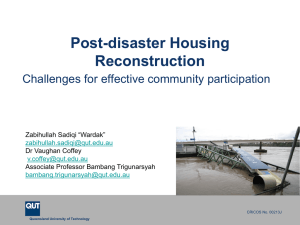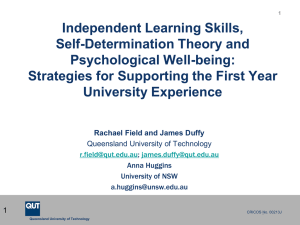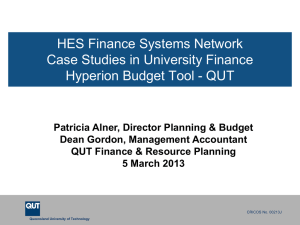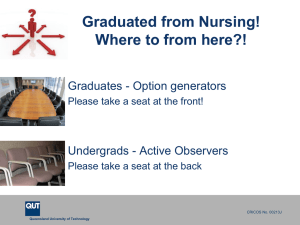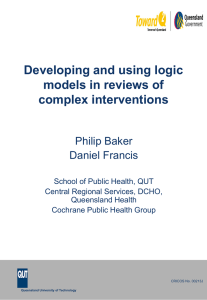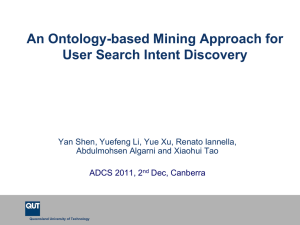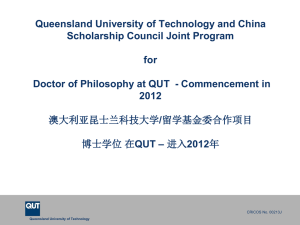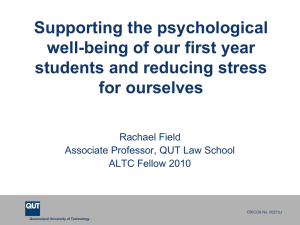real - Australian Disability and Development Consortium (ADDC)
advertisement
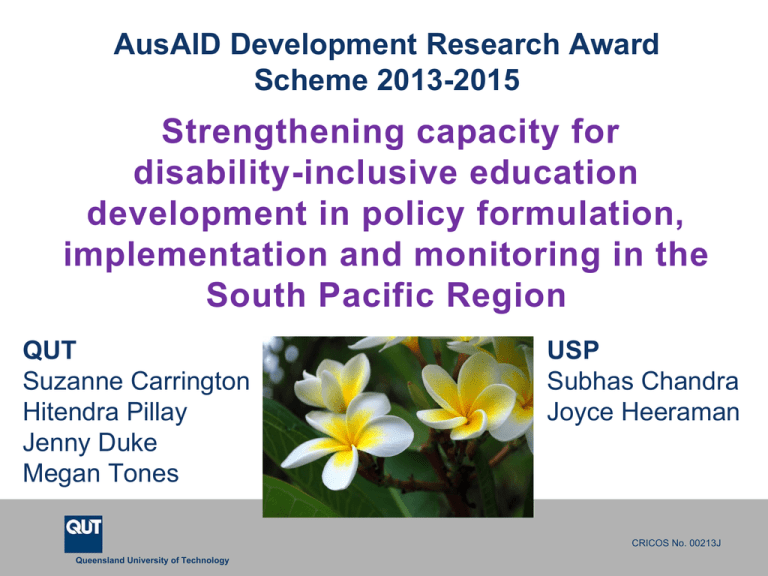
AusAID Development Research Award Scheme 2013-2015 Strengthening capacity for disability-inclusive education development in policy formulation, implementation and monitoring in the South Pacific Region QUT Suzanne Carrington Hitendra Pillay Jenny Duke Megan Tones USP Subhas Chandra Joyce Heeraman CRICOS No. 00213J Queensland University of Technology Overview • Purposes of the Project • Research Questions • Research Team • Design & Methodology • Procedures • Data Collection - The Index for Inclusion • Phases of the Research Process • Ongoing Communication, Engagement & Outcomes • References a university for the real world R CRICOS No. 00213J Purposes of the Project • Progress culturally-appropriate inclusive education in Fiji, Vanuatu, Samoa & Solomon Islands • Develop capacity of all involved (equal partners) • Ensure that progress towards inclusive education is sustainable • Inclusive education is a response to global concerns that all children have the right to access and complete a free and compulsory education that is responsive to the needs and relevant to their lives (UNESCO, 2000) a university for the real world R CRICOS No. 00213J Research Questions 1. What are existing data in relation to disabilityinclusive development? 2. What are the regional, national and local priorities for progressing disability-inclusive education? 3. How can action-research projects contribute to building capacity and progressing sustainable disability-inclusive development in school communities? a university for the real world R CRICOS No. 00213J Research Team a university for the real world R CRICOS No. 00213J Design and Methodology Phase 1 of Project (Archival Review) Phase 2 of Project (Action Research Case Studies) RQ1. Existing Data RQ2. Country Priorities RQ3. School Case Studies Situational Analysis Needs Analysis Action Research - Document analysis -Document analysis - Questionnaires -Individual and focus group interviews Phase 1-3 of Index for Inclusion a university for the real world -Questionnaires -Individual and focus group interviews Phase 4-5 of Index for Inclusion R CRICOS No. 00213J Phase 1 – Archival Review • Situational analysis of potential factors influencing the development, advancement and outcomes of inclusive education in Fiji, Samoa, Solomon Islands and Vanuatu (Armstrong, Armstrong & Spandagou, 2010; McConkey & Bradley, 2010). • Literature review and consultation with national researchers to confirm findings. Examples of literature include: – Country specific policy documents – NGO reports – Journal articles and books a university for the real world R CRICOS No. 00213J Country/ Region Context • Pacific Region Profile – Social perceptions of disability in the Pacific – Opportunities and challenges for people living with disability in the Pacific – Educational context and resources for people with disbilities • Country Specific Profiles – Geography and general population statistics – Background and history of the education of children with disabilities (including available data) a university for the real world R CRICOS No. 00213J Rights of Children with Disabilities (McConkey & Bradley, 2010) • UN Declarations (Equal Rights) – Have the countries ratified the Convention on the Rights of the Child and Rights of Persons with Disabilities? • National Laws (Social Justice) – Are above covered in national laws e.g. legal and constitutional provisions and legislation on education for people with special educational needs. • Policy Guidance (Fair Implementation) – Inclusive and special education policies directed towards schools. • Rights promotion/ Advocacy – e.g. Disabled Persons’ Organisations, Parents’ associations, Non-Government Organisations (coalitions of common interest). a university for the real world R CRICOS No. 00213J Example: Rights of Children with Disabilities Fiji Samoa Ratified Convention on Rights of the Child Ratified Convention on Rights of Persons with Disabilities Solomon Is Vanuatu Signed only Signed only Compulsory Education Legislation Special/ Inclusive Education Policy Mentioned in Strategic Plan a university for the real world R CRICOS No. 00213J Summary Phase 1 • The ongoing review of archival documents shows that there is a real need for research and data collection to provide evidence for effective and sustainable inclusive education for students with disabilities in the Pacific. • Phase 2 of this study is intended to address this by conducting action research in inclusive schools. a university for the real world R CRICOS No. 00213J Phase 2 – Action Research Case Studies • The action research case studies will be conducted in at least two schools per participant country. • Inclusive education will be facilitated via the Index for Inclusion (Booth & Ainscow, 2002) a university for the real world R CRICOS No. 00213J Design & Methodology (RQ’s 2 & 3) • DESIGN – participatory action research within volunteer school communities (case studies) • PARTICIPANTS – young people with disability, their parents/carers, their peers, their teachers, their school principal & community professionals • DATA COLLECTION – questionnaires, individual & focus group interviews (based on the Index for Inclusion) • DATA ANALYSES a university for the real world R CRICOS No. 00213J The Index Process Phase One: Starting the Index Process Phase Two: Finding out about the school Phase Three: Producing an inclusive development plan (i.e., set priorities and plan first cycle of action research) a university for the real world R CRICOS No. 00213J The Index Process Phase Four: Implementing developments Phase Five: Reviewing the Index process Figure 1- A cyclic and spiral process incorporating the phases of planning, implementation and review. a university for the real world R CRICOS No. 00213J Data Collection The Index for Inclusion • Questionnaires, individual interviews and focus group interviews will be based on the three dimensions of the Index for Inclusion – Dimension 1: Creating inclusive cultures – Dimension 2: Producing inclusive policies – Dimension 3: Evolving inclusive practices • The questions will be adapted from those suggested in the Index – e.g., Dimension 3 - ‘Are students encouraged to take responsibility for their own learning?’ a university for the real world R CRICOS No. 00213J a university for the real world R CRICOS No. 00213J a university for the real world R CRICOS No. 00213J Induction and Capacity Building: Research Team • Phase 1: Establishing the Foundation (Complete) – Regional Workshop at USP (roles & responsibilities) • Phase 2: Reviewing and Setting Priorities (Complete) – Regional Workshop at USP (baseline data & procedures) • Phase 3: Planning, Implementing and Knowledge Transfer – Local Action Research Sessions at Schools (establish teams & procedures) • Phase 4: Reviewing and Building Capacity – Local Action Research Sessions at Schools (research outcomes & planning) – Regional Workshop at USP (outcomes & recommendations) • Phase 5: Ensuring Sustainability – National Workshops – Fiji, Vanuatu, Samoa & Solomon Islands a university for the real world R CRICOS No. 00213J Ongoing Communication, Engagement & Outcomes • Progress and outcomes will be shared among the research groups/participants (and interested others): – – – – – – – – – – – Site visits to schools and communities Regular email & Skype video-conferences Action Research Sessions (at schools) Workshops (at USP Suva) Engagement with the Pacific Disability Forum USP as ‘hub’ for training/resources – culturally appropriate approaches to disability-inclusive education Visual representations (photos & videos) Newsletters, Materials & Resources (USP & PIFS) Academic & professional journal articles Colloquia and workshops at QUT Faculty of Education Media releases a university for the real world R CRICOS No. 00213J References • Armstrong, A. C., Armstrong, D. & Spandagou, I. (2010). Inclusive Education: International Policy and Practice. London, UK: SAGE Publications. • Booth, T. & Ainscow, M. (2011). Index for inclusion: Developing learning and participation in schools. Bristol, UK: Centre for Studies on Inclusive Education. • McConkey, R. & Bradley, A. (2010). Promoting inclusive education in low-income countries. In: A Long Walk to School: International Research on Inclusive Education across the Life-Span. (Eds: Timmons, Vianne and Walsh, Patricia Noonan), Sense Publishers, pp. 7-26. ISBN 978-94-6091-211-5 • UNESCO (2000). The Dakar framework for action, education for all: Meeting our collective commitments. Paris: Author. Retrieved from http://unesdoc.unesco.org/images/0012/001211/121147e.pdf • UNESCO (2001). Understanding and responding to children’s needs in inclusive classrooms. Paris: Author. Retrieved from http://unesdoc.unesco.org/images/0012/001243/124394E.pdf • UNESCO (2003). Overcoming exclusion through inclusive approaches in education: A challenge and a vision. Conceptual paper. Paris: Author. Retrieved from http://unesdoc.unesco.org/images/0013/001347/134785e.pdf • UNESCO (2004). Changing teaching practices: Using curriculum differentiation to respond to students’ diversity. Paris: Author. Retrieved from http://unesdoc.unesco.org/images/0013/001365/136583e.pdf • UNESCO (2005). Guidelines for inclusion: Ensuring access to education for all. Paris: Author. Retrieved from http://unesdoc.unesco.org/images/0014/001402/140224e.pdf • UNESCO (2009). Policy guidelines on inclusion in education. Paris: Author. Retrieved from http://unesdoc.unesco.org/images/0017/ 001778/177849e.pdf a university for the real world R CRICOS No. 00213J
